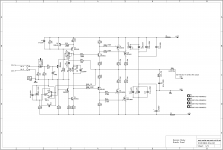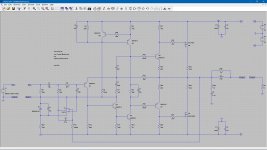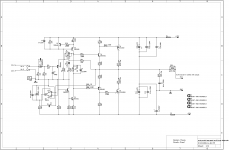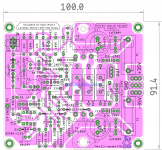Thank you Hugh.
I hope it's useful to someone or gives ideas to make their own...
regards
Prasi
I hope it's useful to someone or gives ideas to make their own...
regards
Prasi
An informal inquiry as to whether there would be enough interest to have a GB started for the Karl Mooly design / pcb as shown by Prasi. Prasi has informed that if enough interest, he would organize the GB.
Regards,
Myles
Regards,
Myles
Hello Kokane,
This PCB design was just an exercise to keep the blade sharp. Its catching rust these days😉.
You may get the PCBs manufactured from the gerbers I posted. For 50-60 USD or so, you could get 10 PCBs delivered to you from China. After you fulfil your needs, rest can be rid off with kind permission of Mooly.
If there is sufficient confirmed requirements, I can do the GB as informed to you.
Regards
Prasi
This PCB design was just an exercise to keep the blade sharp. Its catching rust these days😉.
You may get the PCBs manufactured from the gerbers I posted. For 50-60 USD or so, you could get 10 PCBs delivered to you from China. After you fulfil your needs, rest can be rid off with kind permission of Mooly.
If there is sufficient confirmed requirements, I can do the GB as informed to you.
Regards
Prasi
Here is the version with nested FB resistor as suggested by Hugh.
Regards
Prasi
Beautiful work Prasi
The dark line across the pcb in post 699, is that a jumper ?
BR
Eric
Last edited:
Hello Eric,
yes, its a insulated jumper-wire in case of single sided pcb, to be populated from bottom side.
For double sided, its not required as there is already a trace on top side (blue line-2.54mm wide)
regards
Prasi
yes, its a insulated jumper-wire in case of single sided pcb, to be populated from bottom side.
For double sided, its not required as there is already a trace on top side (blue line-2.54mm wide)
regards
Prasi
Ok but why connect a jumper, i don’t think you need one. Just connect to R20.
It’s hard to verify since I don’t have the updated schematic.
Is the Gerber you very kindly provided double face ?
Thanks
Eric
It’s hard to verify since I don’t have the updated schematic.
Is the Gerber you very kindly provided double face ?
Thanks
Eric
Last edited:
Prasi,
Sorry, I guess I did not understand what information was conveyed in our PM's. If the Moderators agree post #702 can be removed, and a GB will not be persued.
Prasi, I will PM you when I decide on my individual requirements, all of course with permission of Mooly.
Best Regards,
Myles
Sorry, I guess I did not understand what information was conveyed in our PM's. If the Moderators agree post #702 can be removed, and a GB will not be persued.
Prasi, I will PM you when I decide on my individual requirements, all of course with permission of Mooly.
Best Regards,
Myles
Why R26?
What is the purpose of R26? It seems to be redundant.
Regards ...
here is the schematic.
What is the purpose of R26? It seems to be redundant.
Regards ...
Sorry, if i havent had it clear... you or anyone can use the gerbers. there is no need to remove post 702.
What is the purpose of R26? It seems to be redundant.
Regards ...
I guess Mooly can answer better, it has a specific reason for inclusion.
Bias Setup.
Comparing simulations of the Mooley to the FX8 with Bimo mods. If you provide sufficient bias, this amplifier should perform just as well as the FX8 with Bimo mods. It should be able to provide very low distortion levels.
What bias current did you setup?
Regards ...
The MMAMFM is more involving to listen to than either the P101 or the MRJ**.
Comparing simulations of the Mooley to the FX8 with Bimo mods. If you provide sufficient bias, this amplifier should perform just as well as the FX8 with Bimo mods. It should be able to provide very low distortion levels.
What bias current did you setup?
Regards ...
Attachments
Increasing R8 in simulation
Hi Mooley, Try increasing R8 slightly and have look at what it does to the distortion. Setting up sufficient biasing should reduce distortion.
Regards ...
I had a little play with this in simulation, and (with the proviso that untested modifications can not be guaranteed) found the stability of the design such that it is pretty much unfazed by whatever you throw at it.
Hi Mooley, Try increasing R8 slightly and have look at what it does to the distortion. Setting up sufficient biasing should reduce distortion.
Regards ...
Attachments
here is the schematic.
regards
Prasi
I think the output is wrong with R26...it seemes to miss the 10R//6uH before the 0.22R (R26)!
The original Mooly schematic!
since they (inductor and 0.22 ohm resistor) are series, it doesnt matter which one comes first. So I think, its ok.
Prasi,
Sorry, I guess I did not understand what information was conveyed in our PM's. If the Moderators agree post #702 can be removed, and a GB will not be persued.
Prasi, I will PM you when I decide on my individual requirements, all of course with permission of Mooly.
Best Regards,
Myles
I have no problem if any of you want to produce PCB's and sell them as a group buy 🙂
What is the purpose of R26? It seems to be redundant.
Regards ...
R26 slightly raises the output impedance changing the way the amplifier interacts with a varying speaker impedance. It is a fundamental part of the design as a whole.
I would advise anyone not to start changing and altering things until you have become fully familiar with how the original design performs when built as intended.
A good friend asked if its possible to make it as a single pair output and reduce the length to less than 100mm to take advantage of low board costs from China .
.
I gave it a try and here is the result.
It has the same features of the earlier board (caps, resistors, etc, even the logo😉).
regards
Prasi
 .
.I gave it a try and here is the result.
It has the same features of the earlier board (caps, resistors, etc, even the logo😉).
regards
Prasi
Attachments
Last edited:
R26 Q&A
Fair enough. I just wanted to check if R26 was a relic or intentional. The main reason I was running a simulation was to check how sensitive the bias current will be for varying R8. And, it was an excuse to see if the TI psice model for the TL071D would work at all.
R26 slightly raises the output impedance changing the way the amplifier interacts with a varying speaker impedance. It is a fundamental part of the design as a whole.
Fair enough. I just wanted to check if R26 was a relic or intentional. The main reason I was running a simulation was to check how sensitive the bias current will be for varying R8. And, it was an excuse to see if the TI psice model for the TL071D would work at all.
- Home
- Amplifiers
- Solid State
- My MOSFET amplifier designed for music




